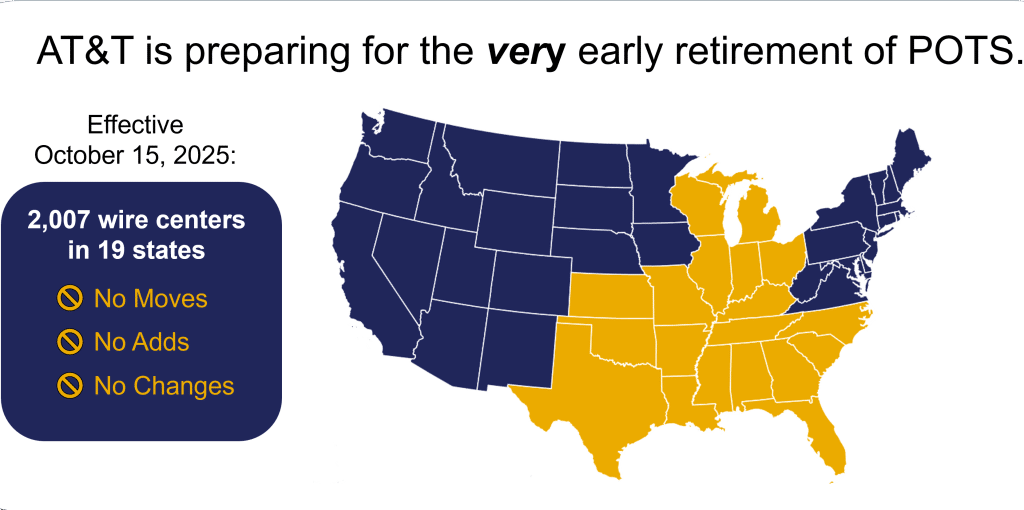Technological advances have had a dramatic impact on the way the world operates. All those miles of copper cables and telephone wires have given us the ability to chat to each other over landlines for generations, but not for much longer. Still, one of the biggest shake-ups on the horizon is the FCC-approved total switch-off of the traditional public switched “landline” telephone network (PSTN, also referred to as POTS which abbreviates for Plain Old Telephone Service).
In August 2019, the FCC released a mandate requiring telephone networks to sunset long-standing PSTN phone line connections, requiring a full phase-out nationwide by 2022 (or possibly 2023).
Any organization with PSTN lines is looking at a significant increase in their telephone bill starting in August 2022. Right now, one line can cost $65-100 per month. After the sunset, that cost could rise into the thousands, with some lines anticipated to cost $3,000 per month.
Why Are PSTN Land Lines Going Away?
The FCC finds PSTN to be unsustainable for several reasons:
1. PSTN Lines Are Expensive
Each PSTN line currently costs an estimated $65 – $100 per line, and multiple can be found throughout an organization.
Beyond their obvious use for voice phone calls, PSTN lines are also used for fax machines, ATMs, elevator emergency call boxes, fire alarms, gate and door access and even HVAC systems. These items add up fast and can put unnecessary strain on any budget.
2. PSTN Copper Wiring is Decades Old and Exposed to the Elements
Copper wires are always at risk of damage from the outside world. Bad weather conditions and natural disasters often leave PSTN lines vulnerable and in need of constant repair and maintenance.
That kind of downtime is unnecessary when digital options, like Unified Communications platforms, are better, and digital service is typically delivered to customers by new fiber optic cables.
3. PSTN Lines Lack Modern Monitoring Abilities
Due to their physical nature, PSTN lines do not have monitoring or remote management like digital platforms provide. That means that when there is damage to your wired network, it is difficult to locate, and you will not know if a line is down until you are actively trying to use it.
When that happens, your entire network will have to be shut down until professionals find what needs fixing. That’s simply no longer efficient.
4. PSTN Lines Face a Retiring Support Workforce
Speaking of professional service, a workforce that once held ample knowledge of PSTN lines is quickly dwindling, leaving few professionals to handle repairs when needed.
Equipment shortages add more fuel to the fire and prevent work from getting done quickly. That’s simply no longer reliable.
Combine all of these factors and you have a recipe for frequent and costly network downtime. The telephone providers made a good argument to the FCC and they were approved to finally abandon the whole thing, mostly because residential customers moved away from landlines almost 10 years ago by now.
Farewell to Analog Technology
Analog network technology is too expensive and difficult to maintain, and beyond that, it’s simply incompatible with the varied demands of modern communications. The future is in digital communication, with calls using VoIP (Voice over Internet Protocol) being routed over fiber-optic lines, cellular connectivity such as 4G, or even increasingly using low power wide area networks (LPWAN).
The problem, however, is that this change doesn’t just impact traditional landlines making voice calls. Many non-voice services currently use the PSTN network, such as faxes, alarms, door entry, and elevators. A new, secure, reliable, and easily installed solution is needed for all of these adjacent technologies. With the switch-off date, looming companies need to take action now. What some might see as a logistical headache is an opportunity for companies to move from the currently fundamental technology to a far more efficient and reliable solution with enhanced performance.
Which Sectors are Going to be Most Affected by the PSTN Switch Off?
Every business today that still uses landline technology for their business phone system will soon be surprised by disconnection of service letters or significant doubling or trippling of monthly service fees to maintain landline service, because the telephone provider you’ve known for decades has been given the government “green-light” of approval to move on from that legacy technology, no longer train repair persons, and no longer maintain the miles and miles of wires underground or overhead. It’s no longer financially practical when so many better solutions exist now.
PSTN plays a crucial role in the utility sector and particularly the water industry by connecting remote outstations, communicating telemetry data, and providing monitoring systems. Water companies are now identifying which solution providers can deliver the best value and innovative solutions for their future site communication needs. Switching away from PSTN requires a significant capital investment. They understandably want to maximize their return by gaining new capabilities such as detailed analytics through cloud applications while meeting their future regulatory objectives.
The legislation mandates that every elevator has to have some form of emergency communications line. Historically, these S.O.S. voice calls were made via cables connected to the PSTN, but any lift systems still using this legacy technology must deploy an alternative communication method by 2025.
Cellular Connectivity for Backup
Cellular connectivity is the simplest, easiest, and fastest solution to deploy to these elevators, offering reliable, always-on connectivity for emergency communication from the lifts 24/7 through roaming or dual SIM solutions.
Companies are also more commonly installing CCTV cameras in their lifts to monitor real-time events such as medical emergencies or assaults. Using a VPN (Virtual Private Network), companies can access two-way data transmissions directly through an encrypted 4G connection for secure remote monitoring, an added benefit of the change.
The infrastructure can also be monitored and maintained over the network even in remote locations, reducing the number of on-site lift maintenance checks and saving money on expensive engineers, equipment, and transport.
One Step Further with 5G
In the future, emerging cellular technologies like 5G have the potential to provide superior penetration into buildings, supporting low-data applications and optimizing deployment and ongoing costs.
Cellular connectivity certainly feels like a suitable replacement for PSTN connections, and this was the recommendation of the Lift and Escalator Industry Association in their press release from November 2019, which discussed the benefits of using cellular networks.
Before proceeding with the switch over, solutions providers must make sure that they choose the best connectivity partner for the job. They need experts who can quickly and easily deploy this technology at scale. To manage thousands of lifts internationally, they must feel confident that their new solution will connect seamlessly to multiple mobile networks and that those connections will be secure, reliable, and easily managed through one integrated platform.
Worried about your business phone system being unprepared by still using landlines? Call us at +1.800.857.1517 to schedule a telecom technology consultation and easily transition your analog equipment today.




